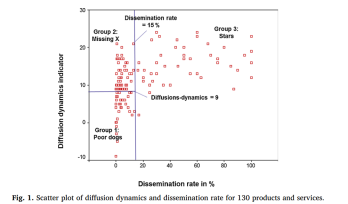On our way to becoming a green economy, we need products and services that have a positive impact on the environment and society. Companies are researching, developing and testing many environmental product and service innovations. Clausen et al. (2019) show that there is not a lack of these innovations, but there is a too low percentage of these innovations that are successful.
Only a third of environmental innovations is successful
Sustainability oriented innovations are successful when they are diffused into the mass market and contribute to transforming society. With only one third of environmental innovations being successful, there is not enough impact to transform the economy. The diffusion throughout the economy and society is too narrow and too slow to solve the urgent challenges of sustainability such as climate protection, biodiversity and resource conservation.
Clausen et al. (2019) studied 130 diffusion cases in different economic sectors such as transportation and mobility, hospitality and nutrition, financial services, rental, green conventional services, scientific-technical services, energy efficient products and services, rental to industry, internet and computing, handcrafted product-service systems, trade, construction and housing, renewable raw materials and renewable energy.
Based on the “Diffusion Dynamics” (a measure of the theoretical diffusion potential) and “Dissemination Rate” (market share), three categories are introduced for products and services:

Poor dogs: low Diffusion Dynamics indicator and a small dissemination rate
Missing X: high Diffusion Dynamics indicator but a small dissemination rate.
Stars: high Diffusion Dynamics indicator and high dissemination rates,
In figure 1 the three categories of new environmental products and services are plotted in a scatter diagram, showing that only one third of the innovations are “stars” or successful in diffusing into the mass market and contributing to transforming society.
What can we learn from the stars?
Successful environmental innovations appear to have three factors that all need to be present. These factors are:
- Market push through extensive marketing, partnerships and effective sales structures that include the concepts as “perceptibility,” “renown and reputation of suppliers,” “completeness and availability of services,” “degree of support of industry trade association,” “degree of resistance/support of market leaders,” “degree of support by intermediaries as change agencies” and “coverage by media and campaigns.”
- Favourable cost-beneft ratio including pointing our the “relative advantage of the innovation,” “fnancial (dis-)advantage/price, costs, cost-effectiveness” and “price development.”
- High compatibility and confidence in the innovation, where the innovation is compatible with the routines and the culture of users, requires only minor behavioural changes, and leads to few uncertainties. This factor also includes “high technical and cultural compatibility,” “low need for behavior modifcation,” “low uncertainty on the part of adopters” and “self-reinforcing social effects.”
What else to do or to avoid to make a sustainability innovation splash?
For companies it is important to keep on innovating and at the same time learn more about what is relevant in every specific innovation case.
The factors that hinder innovation are the necessity to change existing behaviour when using a new environmental products and services, or the perceived uncertainties on the part of consumers. It is therefore important to co-create where possible new environmental products and services.
Literature
Clausen, J., & Fichter, K. (2019). The diffusion of environmental product and service innovations: Driving and inhibiting factors. Environmental Innovation and Societal Transitions.
Photo by AHMED… on Foter.com / CC BY-NC-ND


Co creation is extremely important but also very difficult.
LikeLiked by 1 person